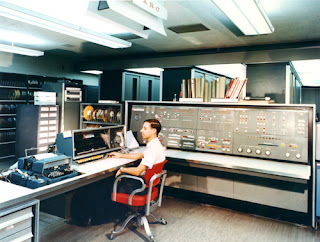What is the future of digital archives? It is a necessary question, and one which is fitting for the final blog post. Over the past few weeks, I have commented on a number of aspects of the digitization movement within history. There are many facets of digitization, and obviously far more than I have been able to touch on. Two dominant themes have risen to the top through the discourse, and if we are to take anything away from all of the information presented, it is that one, preservation, and two, accessibility, are key.
 |
| Sadly, old tech doesn't age this well. |
The discourse over preservation is dominated by the quandary of how to keep all of the information within digital collections accessible. Obsolescence and data loss are both very real dangers which must be contended with in order to make long term storage of digital historical resources viable. Obsolescence is tackled in a number of different ways. Information can be recopied (refreshed) periodically to preserve it. It can, and indeed must, be transferred (migrated) into every newer formats so that it can remain accessible. If that fails, historians must be at least familiar with the concept of emulation—the use of a virtual environment wherein information stored in older formats can be accessed using newer machines. And, of course, we must always, ALWAYS, remember to back up our information. Putting all of our proverbial eggs in one basket could easily lead to lots of broken eggs and nothing to eat for breakfast. If we are to derive any sort of benefit from the digital information that we are storing now, we ensure that it will survive into the future, and also employ measures to allow future archivists to use it.
 |
| Digital archives must learn to avoid the fate of so much hardware. |
Sadly enough, some reputable sources define long term storage of digital information as being no more than half a decade. This is simply unacceptable. While the digital medium is infinitely more fragile and vulnerable to the vicissitudes of time, simply making excuses will do nothing to address the problem. This could easily lead to a “digital dark age”, or a time in the no-so-distant future when all of the information that we have collected so far is irreparably lost. Both the public and private sectors are aware of this fact, which is why we can see marked growth in the field of digital archivists. These men and women are professional information shepherds, charged with watching over the vast collections of digital information which have already been collected, and make sure that they survive into the next generation.
 |
| An image from the Polar Bear Collection website. |
Alongside the battle to preserve digital archives, there is the continued efforts to make the information easier to access and use. At the head of these efforts are experiments such as the Polar Bear Expedition Digital Collection, an online archive hosted by the University of Michigan. Employing all manner of user tools, such as bookmarking, comments, and link paths, the site attempted to generate greater user interest by making the information easily accessible. Their findings, while not always what was expected, yielded useful information which can be used by others who are striving towards the same ends. Efforts such as this are extremely important. If the information we are going to all the trouble to save is ignored and falls into disuse, then it is no better off than if it had simply been lost.
The digital age is still fairly young, and the lessons which must be learned to effectively harness the tools of this age are still being discovered. We must be quick studies if we are to keep from losing much of what we have gained so far.







